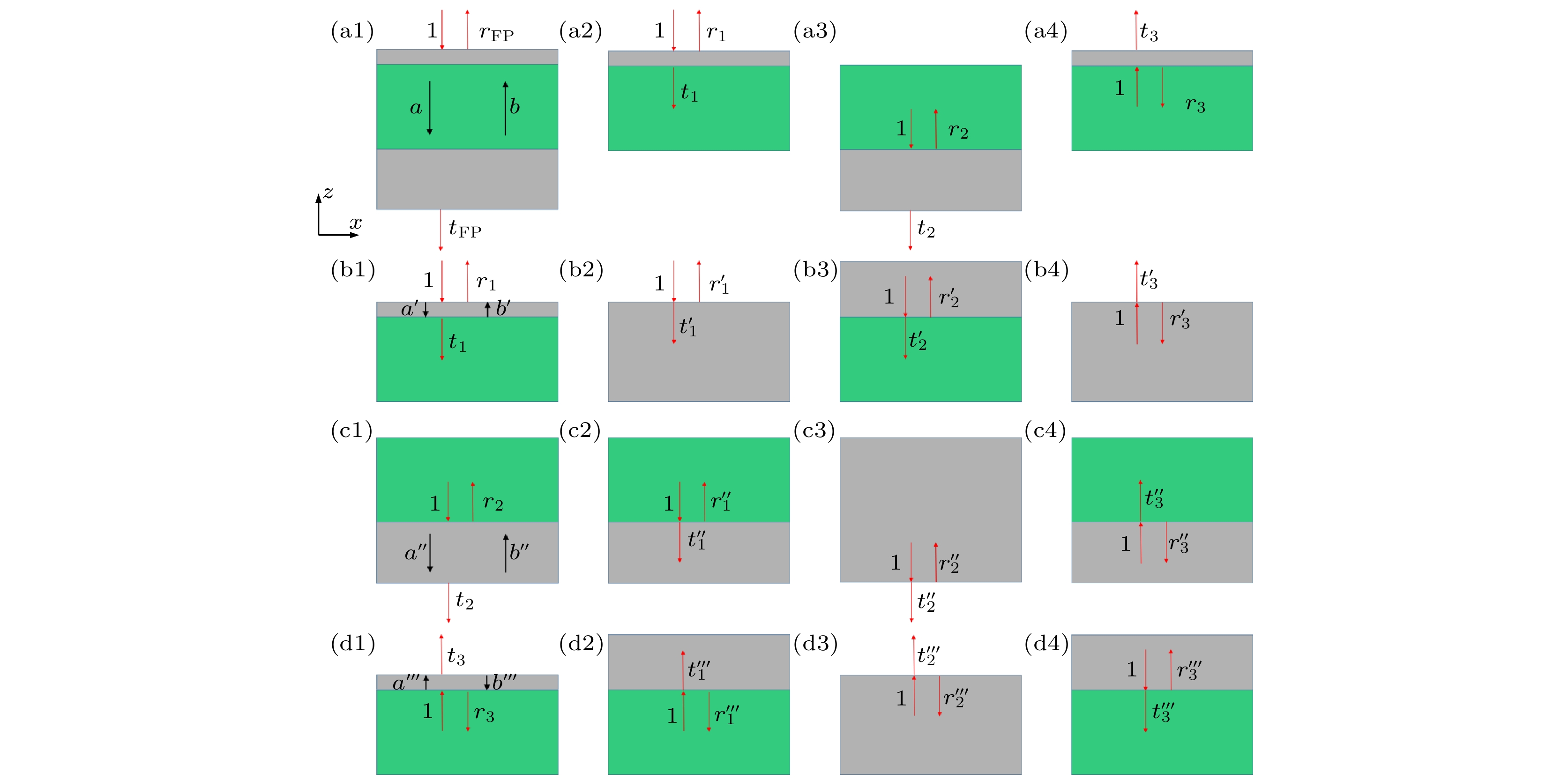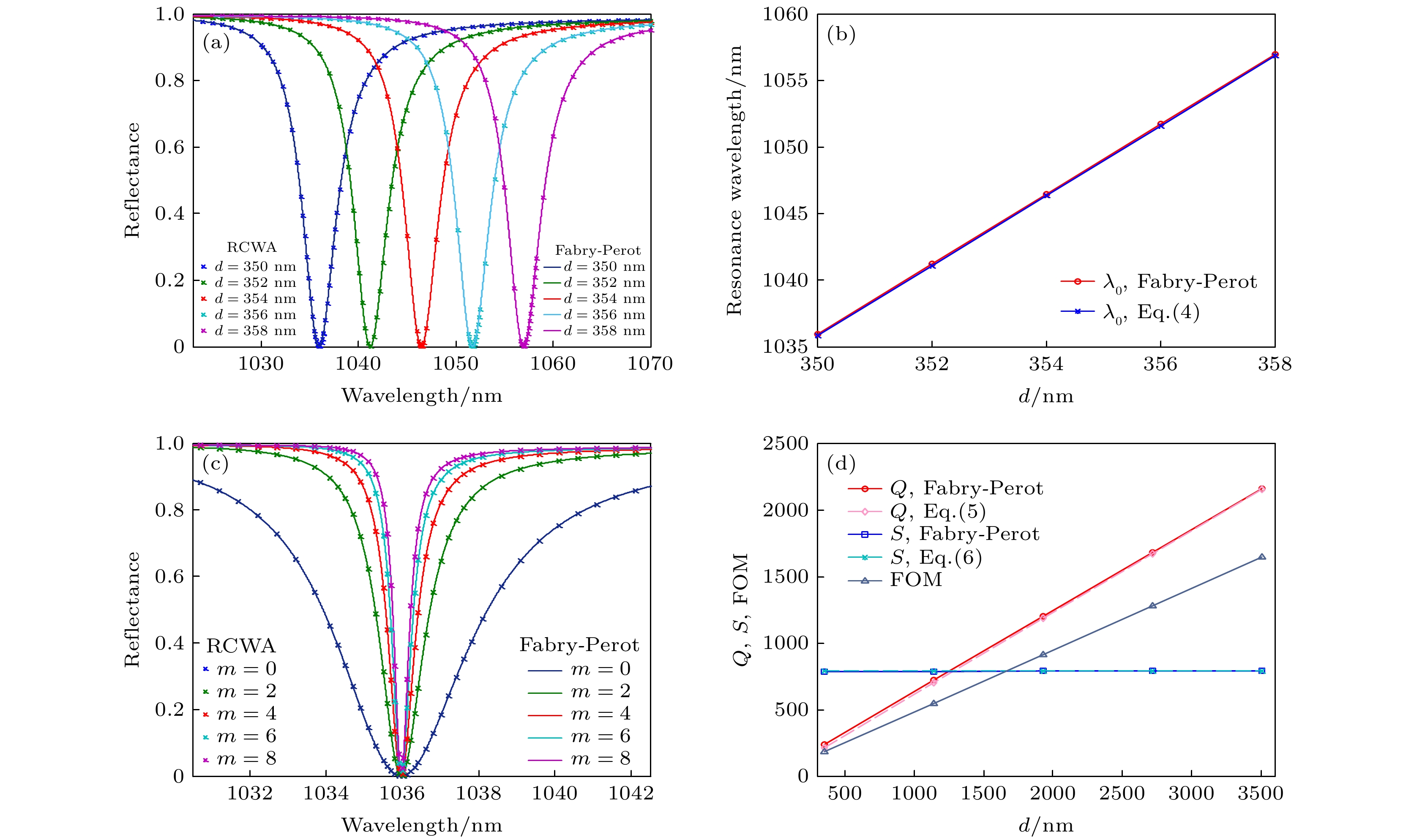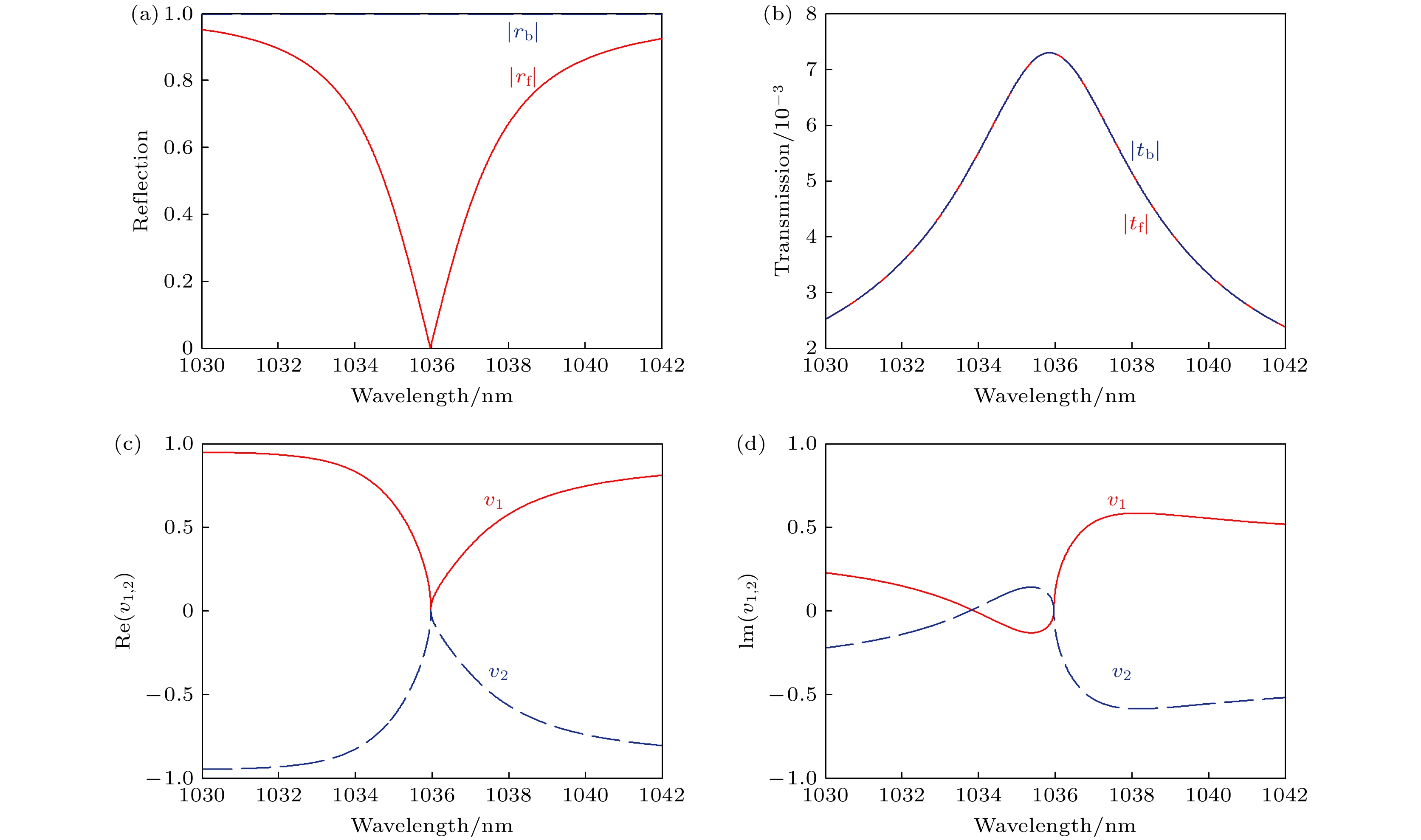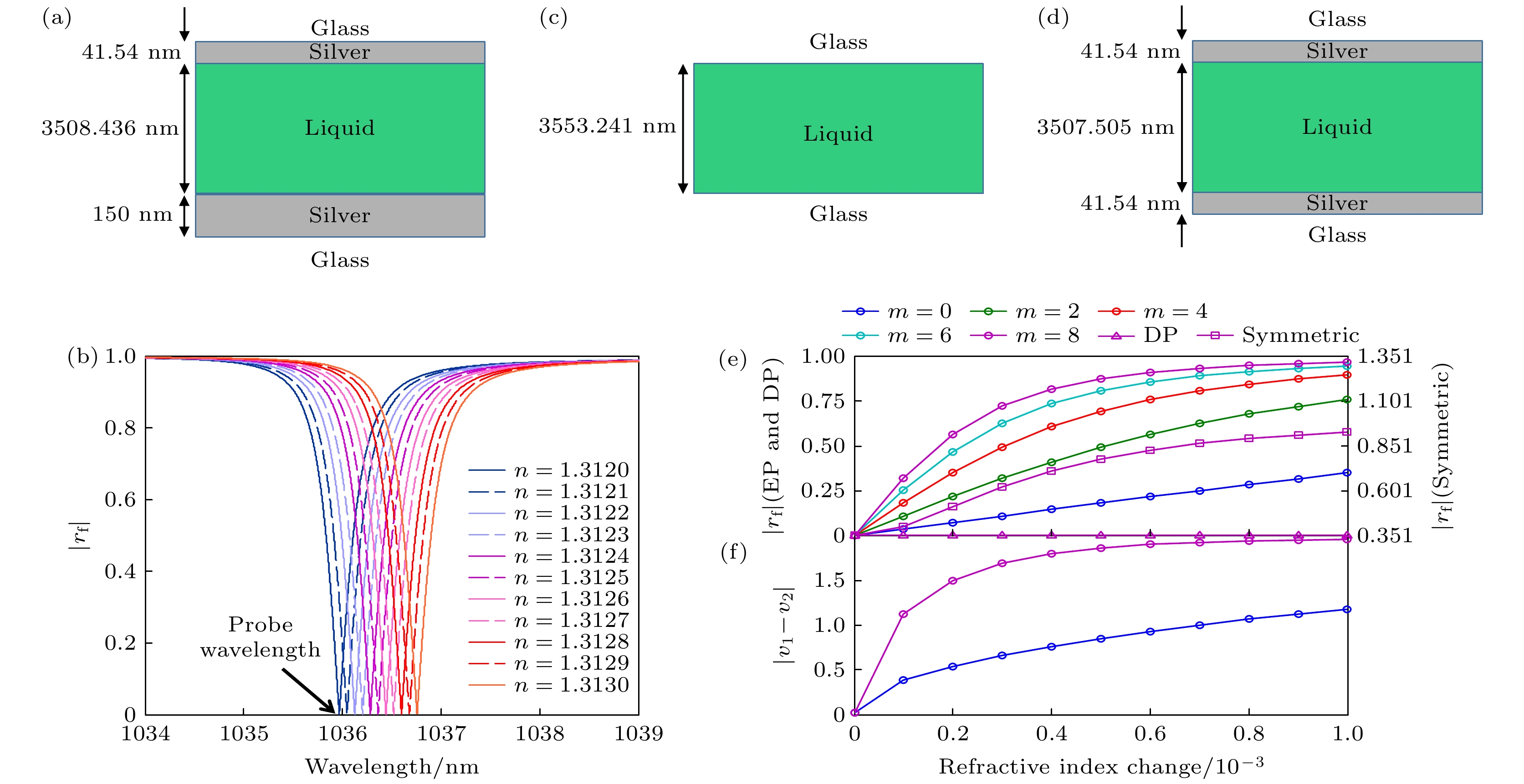-
顶层透光、底层不透光的金属-介质-金属多层结构可以产生窄带完美吸收共振, 用于测量介质层待测液体的折射率变化. 本文通过构建Fabry-Perot共振解析模型, 准确复现了该结构的响应光谱, 给出了其共振波长、品质因子、半高全宽和灵敏度的解析表达式, 并分析了介质层厚度对光谱的谐振波长和线宽的调谐机制, 明确了其物理机理. 基于8阶Fabry-Perot共振的金属-介质-金属多层结构, 用于折射率传感时的品质因子及优值分别达到2162.8和1648.1 RIU–1. 针对极小的折射率扰动, 通过在奇异点状态叠加Fabry-Perot共振的调谐机制, 提出了通过测量奇异点波长处反射系数的增加量或散射矩阵本征值的分裂量, 实现对待测液体折射率的可调谐式传感的方案. Fabry-Perot模型解析结果显示, 当待测液体的折射率变化为10–4 RIU时, 基于8阶Fabry-Perot共振的金属-介质-金属多层结构的前向反射系数增加量和本征值分裂量分别达到0.319和1.1279.
-
关键词:
- 金属-介质-金属谐振器 /
- Fabry-Perot共振模型 /
- 可调谐式传感 /
- 奇异点
The metal-dielectric-metal multilayer structure sensor with a transparent top layer and an opaque bottom layer is proposed, which can provide a perfect narrow-band absorption resonance and is suitable for sensing refractive index change of the liquid to be measured in dielectric layer. The Fabry-Perot resonance analytical model that can accurately reproduce response spectrum and theoretically analyze the mechanism of the dielectric layer thickness to tune resonance wavelength and linewidth of response spectrum is constructed. Theoretical analysis shows that the resonance wavelength is directly proportional to the thickness of dielectric layer, and the full width at half maximum is inversely proportional to the thickness of dielectric layer. The analytical expressions for its resonance wavelength, quality factor, full width at half maximum and sensitivity are also given. When used for the refractive index sensing, the quality factor and figure of merit of the proposed multilayer structure based on the 8th order Fabry-Perot resonance are 2162.8 and 1648.1 RIU–1, respectively. However, due to the influence of the minimum resolution of the spectrometer, the conventional method of measuring resonance wavelength shift to achieve refractive index sensing has a high measurement limit. For the sensing of weaker refractive index perturbation, with the help of superposition of exceptional point degenerate state and tuning mechanism of Fabry-Perot resonance, in this paper proposed is a method of tunably sensing the liquid refractive index by measuring the increase of reflection coefficient or splitting of eigenvalue at a specific wavelength. Here, we take for example the metal-dielectric-metal multilayer structure sensor based on the 8th order Fabry-Perot resonance. According to the calculation results of Fabry-Perot model, when the change in refractive index of liquid to be measured is 10–4 RIU, the increase of forward reflection coefficient and the splitting of two eigenvalues of the scattering matrix are 0.319 and 1.1279, respectively.-
Keywords:
- metal-dielectric-metal resonator /
- Fabry-Perot resonance model /
- tunable sensing /
- exceptional point
[1] Kocer H, Butun S, Palacios E, Liu Z, Tongay S, Fu D, Wang K, Wu J, Aydin K 2015 Sci. Rep. 5 13384
 Google Scholar
Google Scholar
[2] Kocer H, Butun S, Li Z, Aydin K 2015 Sci. Rep. 5 8157
 Google Scholar
Google Scholar
[3] Gomes de Souza I L, Rodriguez-Esquerre V F 2019 Sci. Rep. 9 7045
 Google Scholar
Google Scholar
[4] Meng Y L, Tan J, Xu K, Chen J, Jin G J, Sun Y, Wang L L, Zuo Z, Qin H Y, Zhao Y, Guo J 2019 Appl. Opt. 58 6700
 Google Scholar
Google Scholar
[5] Williams C, Rughoobur G, Flewitt A J, Wilkinson T D 2016 Appl. Opt. 55 9237
 Google Scholar
Google Scholar
[6] Gomes de Souza I L, Rodriguez-Esquerre V F, Rêgo D F 2018 Appl. Opt. 57 6755
 Google Scholar
Google Scholar
[7] Zhao H, Chen Z, Zhao R, Feng L 2018 Nat. Commun. 9 1764
 Google Scholar
Google Scholar
[8] Yim J, Zhao H, Midya B, Feng L 2019 Opt. Lett. 44 1626
 Google Scholar
Google Scholar
[9] Qin L, Wu S, Zhang C, Li X 2019 IEEE Sens. J. 19 2924
 Google Scholar
Google Scholar
[10] Katyal J, Soni R K 2014 Plasmonics 9 1171
 Google Scholar
Google Scholar
[11] 王文慧, 张孬 2018 物理学报 67 247302
 Google Scholar
Google Scholar
Wang W H, Zhang N 2018 Acta Phys. Sin. 67 247302
 Google Scholar
Google Scholar
[12] Lu X, Zhang T, Wan R, Xu Y, Zhao C, Guo S 2018 Opt. Express 26 10179
 Google Scholar
Google Scholar
[13] Liao Y L, Zhao Y 2020 Sci. Rep. 10 1480
 Google Scholar
Google Scholar
[14] Chen L, Cao Z, Shen Q, Deng X, Ou F, Feng Y 2007 J. Lightwave Technol. 25 539
 Google Scholar
Google Scholar
[15] Chen L, Cao Z, Ou F, Li H, Shen Q, Qiao H 2007 Opt. Lett. 32 1432
 Google Scholar
Google Scholar
[16] Liao Y L, Zhao Y 2015 Plasmonics 10 1219
 Google Scholar
Google Scholar
[17] Li Q, Li Z, Xiang X, Wang T, Yang H, Wang X, Gong Y, Gao J 2019 Coatings 9 393
 Google Scholar
Google Scholar
[18] Midya B, Zhao H, Feng L 2018 Nat. Commun. 9 2674
 Google Scholar
Google Scholar
[19] Miri M A, Alù A 2019 Science 363 eaar7709
 Google Scholar
Google Scholar
[20] 张翔宇, 康明, 刘会刚, 刘海涛 2020 中国激光 47 0300001
 Google Scholar
Google Scholar
Zhang X Y, Kang M, Liu H G, Liu H T 2020 Chin. J. Lasers 47 0300001
 Google Scholar
Google Scholar
[21] Wiersig J 2020 Photonics Res. 8 1457
 Google Scholar
Google Scholar
[22] Huang Y, Shen Y, Min C, Fan S, Veronis G 2017 Nanophotonics 6 977
 Google Scholar
Google Scholar
[23] Bai R, Zhang C, Gu X, Jin X R, Zhang Y Q, Lee Y 2017 Sci. Rep. 7 10742
 Google Scholar
Google Scholar
[24] Pommet D A, Grann E B, Moharam M G, Gaylord T K 1995 J. Opt. Soc. Am. A 12 1068
 Google Scholar
Google Scholar
[25] Wang N F, Kuo T W, Tsai Y Z, Lin S X, Hung P K, Lin C L, Houng M P 2012 Opt. Express 20 7445
 Google Scholar
Google Scholar
[26] Do T T, Gubanova L A, Putilin E S, Khoa P V 2014 J. Opt. Technol. 81 612
 Google Scholar
Google Scholar
[27] Lalanne P, Yan W, Vynck K, Sauvan C, Hugonin J P 2018 Laser Photonics Rev. 12 1700113
 Google Scholar
Google Scholar
[28] Wan J, Zhu J, Zhong Y, Liu H 2018 J. Opt. Soc. Am. A 35 880
 Google Scholar
Google Scholar
[29] Meng Z, Cao H, Liu R, Wu X 2020 Sensors 20 2301
 Google Scholar
Google Scholar
[30] Ren X, Ren K, Ming C 2018 Sensors 18 1376
 Google Scholar
Google Scholar
[31] 祁云平, 张婷, 郭嘉, 张宝和, 王向贤 2020 物理学报 69 167301
 Google Scholar
Google Scholar
Qi Y P, Zhang T, Guo J, Zhang B H, Wang X X 2020 Acta Phys. Sin. 69 167301
 Google Scholar
Google Scholar
[32] Lan G, Jin Z, Nong J, Luo P, Guo C, Sang Z, Dong L, Wei W 2020 Appl. Sci. 10 2295
 Google Scholar
Google Scholar
[33] Liu H, Zheng L, Ma P, Zhong Y, Liu B, Chen X, Liu H 2019 Opt. Express 27 13252
 Google Scholar
Google Scholar
[34] Chen J, Nie H, Tang C, Cui Y, Yan B, Zhang Z, Kong Y, Xu Z, Cai P 2019 Appl. Phys. Express 12 052015
 Google Scholar
Google Scholar
[35] Vassallo C 1991 Optical Waveguide Concepts (Netherlands: Elsevier) pp18−24
[36] Demange G, Graefe E M 2011 J. Phys. A: Math. Theor. 45 25303
 Google Scholar
Google Scholar
[37] Wiersig J 2016 Phys. Rev. A 93 033809
 Google Scholar
Google Scholar
-
图 1 (a) MDM多层结构示意图, 箭头表示均匀平面波的传播方向, 红色、蓝色箭头对应前向、后向入射均匀平面波; (b) 前向反射率R、透射率T和吸收率A的光谱; (c) 不同玻璃层厚度dGlass对应的反射率谱, 蓝色实线表示玻璃厚度无限大时的反射率谱(即图(b)中的红色实线), 插图为上下玻璃层均为有限厚度时的结构示意图; (d) 双层增透膜结构的反射率谱, 插图表示位于空气、玻璃之间的双层增透膜结构; (e) 不同玻璃层厚度dGlass对应的反射率谱, 蓝色实线表示玻璃厚度无限大时的反射率谱, 插图为上下玻璃层均为有限厚度且玻璃表面镀双层增透膜的结构示意图
Fig. 1. (a) Schematic of MDM multilayer structure. The solid arrows indicate the propagation directions of plane waves. The red and blue arrows correspond to forward and backward travelling incident plane waves, respectively. (b) Spectra of forward reflectance R, transmittance T and absorptance A of the proposed structure. (c) Reflectance spectra for different thicknesses dGlass of the glass layer, where the blue solid curve corresponds to infinite glass thickness [i.e. the red solid curve in Fig. (b)]. The inset shows the structure diagram with upper and lower glass layers set to have a finite thickness. (d) Reflectance spectra of the double-layer antireflection coating. The inset shows the structure of the double-layer antireflection coating between the air and glass regions. (e) Reflectance spectra for different thicknesses dGlass of the glass layer, where the blue solid curve corresponds to infinite glass thickness. The inset shows the structure diagram where the upper and lower glass layers are both set to have a finite thickness and both glass surfaces are coated with the double-layer antireflection coating.
图 3 Fabry-Perot模型 (a1) MDM结构中待求解的反射系数rFP, 透射系数tFP, 介质层中模式系数a, b的定义; (a2)—(a4) Fabry-Perot模型中双金属界面散射系数r1, t1, r2, t2, r3, t3的定义; (b1)—(b4) 对于r1, t1的Fabry-Perot模型, 中间金属层模式系数a', b'的定义, 以及单界面散射系数定义; (c1)—(c4) 对于r2, t2的Fabry-Perot模型, 相应的金属层模式系数和单界面散射系数定义; (d1)—(d4) 对于r3, t3的Fabry-Perot模型, 相应的金属层模式系数和单界面散射系数定义
Fig. 3. Fabry-Perot model: (a1) Definitions of reflection coefficient rFP, transmission coefficient tFP to be solved in MDM structure, and mode coefficients a, b in dielectric layer; (a2)–(a4) definitions of bimetal interface scattering coefficients r1, t1, r2, t2, r3, t3 in Fabry-Perot model; (b1)–(b4) Fabry-Perot model of r1 and t1, definitions of mode coefficients a', b' in intermediate metal layer, and single interface scattering coefficients; (c1)–(c4) Fabry-Perot model of r2 and t2, the corresponding metal layer mode coefficients and single interface scattering coefficients are defined; (d1)–(d4) Fabry-Perot model of r3 and t3, the corresponding metal layer mode coefficients and single interface scattering coefficients are defined.
图 4 (a) 不同介质层厚度d对应的反射率谱曲线, 点表示RCWA数值仿真结果, 实线表示Fabry-Perot模型计算结果; (b) 谐振波长随介质层厚度d的变化, 红色和蓝色实线表示Fabry-Perot模型和方程(4)的计算结果; (c) 不同谐振阶次m对应同一谐振波长1035.967 nm时(m越大则d越大), RCWA计算(点)、Fabry-Perot模型(实线)给出的反射率谱曲线; (d) Q, FOM, S随d的变化, 红色、蓝色和灰色实线代表由Fabry-Perot模型计算的反射率谱得到的Q, S, FOM, 粉色和青色虚线代表方程(5)和(6)计算的Q, S
Fig. 4. (a) Reflectance as a function of wavelength for variable dielectric layer thicknesses d, dots represent RCWA numerical simulation results, solid lines represent Fabry-Perot analytical model calculation results; (b) resonance wavelength as a function of dielectric layer thickness d, red and blue solid lines represent the calculation results of Fabry-Perot model and Eq. (4); (c) reflectance spectrums given by RCWA calculation (dots) and Fabry-Perot model (solid lines), and different resonance orders m correspond to the same resonance wavelength 1035.967 nm (larger m is, larger d is); (d) Q, FOM, S as a function of d, red, blue and gray solid lines represent Q, S, FOM obtained from reflectance spectrum calculated by Fabry-Perot model, pink and cyan dotted lines represent Q, S calculated by Eqs. (5) and (6).
图 5 奇异点简并 (a) 前向(红色实线)和后向(蓝色虚线)反射系数光谱; (b) 前向(红色实线)和后向(蓝色虚线)透射系数光谱; (c), (d) 散射矩阵本征值ν1 (红色实线)、ν2 (蓝色虚线)的实部和虚部随波长变化的曲线
Fig. 5. Exceptional point degeneracy: (a) Spectra of forward (red solid line) and backward (blue dashed line) reflection; (b) spectra of forward (red solid line) and backward (blue dashed line) transmission; (c), (d) real and imaginary parts of eigenvalue ν1 (red solid line), ν2 (blue dashed line) of the scattering matrix vary with wavelength.
图 6 (a) 基于8阶Fabry-Perot共振的EP简并系统; (b) EP简并系统的前向反射系数光谱随折射率n的变化, 竖直黑色实线表示观测波长; (c) DP简并系统; (d) 对称银层系统; (e) 前向反射系数随折射率微扰的变化曲线, 圆圈实线对应基于Fabry-Perot共振(取不同阶次m)的EP简并系统, 三角和方形实线分别对应DP简并系统和对称银层系统; (f) m = 0和m = 8时本征值分裂量随折射率微扰的变化曲线
Fig. 6. (a) EP degenerate system based on 8 th order Fabry-Perot resonance; (b) forward reflection coefficient spectra of the EP degenerate system versus refractive index n, where the vertical black solid line represents the observation wavelength; (c) DP degenerate system; (d) symmetrical silver layer system; (e) forward reflection coefficient as a function of refractive index perturbation, where circle solid lines correspond to the EP systems based on Fabry-Perot resonance (taking different orders m), and triangular and square solid lines correspond to the DP degenerate system and the symmetrical silver layer system, respectively; (f) eigenvalue splitting amount as a function of the refractive index perturbation for m = 0 and m = 8.
-
[1] Kocer H, Butun S, Palacios E, Liu Z, Tongay S, Fu D, Wang K, Wu J, Aydin K 2015 Sci. Rep. 5 13384
 Google Scholar
Google Scholar
[2] Kocer H, Butun S, Li Z, Aydin K 2015 Sci. Rep. 5 8157
 Google Scholar
Google Scholar
[3] Gomes de Souza I L, Rodriguez-Esquerre V F 2019 Sci. Rep. 9 7045
 Google Scholar
Google Scholar
[4] Meng Y L, Tan J, Xu K, Chen J, Jin G J, Sun Y, Wang L L, Zuo Z, Qin H Y, Zhao Y, Guo J 2019 Appl. Opt. 58 6700
 Google Scholar
Google Scholar
[5] Williams C, Rughoobur G, Flewitt A J, Wilkinson T D 2016 Appl. Opt. 55 9237
 Google Scholar
Google Scholar
[6] Gomes de Souza I L, Rodriguez-Esquerre V F, Rêgo D F 2018 Appl. Opt. 57 6755
 Google Scholar
Google Scholar
[7] Zhao H, Chen Z, Zhao R, Feng L 2018 Nat. Commun. 9 1764
 Google Scholar
Google Scholar
[8] Yim J, Zhao H, Midya B, Feng L 2019 Opt. Lett. 44 1626
 Google Scholar
Google Scholar
[9] Qin L, Wu S, Zhang C, Li X 2019 IEEE Sens. J. 19 2924
 Google Scholar
Google Scholar
[10] Katyal J, Soni R K 2014 Plasmonics 9 1171
 Google Scholar
Google Scholar
[11] 王文慧, 张孬 2018 物理学报 67 247302
 Google Scholar
Google Scholar
Wang W H, Zhang N 2018 Acta Phys. Sin. 67 247302
 Google Scholar
Google Scholar
[12] Lu X, Zhang T, Wan R, Xu Y, Zhao C, Guo S 2018 Opt. Express 26 10179
 Google Scholar
Google Scholar
[13] Liao Y L, Zhao Y 2020 Sci. Rep. 10 1480
 Google Scholar
Google Scholar
[14] Chen L, Cao Z, Shen Q, Deng X, Ou F, Feng Y 2007 J. Lightwave Technol. 25 539
 Google Scholar
Google Scholar
[15] Chen L, Cao Z, Ou F, Li H, Shen Q, Qiao H 2007 Opt. Lett. 32 1432
 Google Scholar
Google Scholar
[16] Liao Y L, Zhao Y 2015 Plasmonics 10 1219
 Google Scholar
Google Scholar
[17] Li Q, Li Z, Xiang X, Wang T, Yang H, Wang X, Gong Y, Gao J 2019 Coatings 9 393
 Google Scholar
Google Scholar
[18] Midya B, Zhao H, Feng L 2018 Nat. Commun. 9 2674
 Google Scholar
Google Scholar
[19] Miri M A, Alù A 2019 Science 363 eaar7709
 Google Scholar
Google Scholar
[20] 张翔宇, 康明, 刘会刚, 刘海涛 2020 中国激光 47 0300001
 Google Scholar
Google Scholar
Zhang X Y, Kang M, Liu H G, Liu H T 2020 Chin. J. Lasers 47 0300001
 Google Scholar
Google Scholar
[21] Wiersig J 2020 Photonics Res. 8 1457
 Google Scholar
Google Scholar
[22] Huang Y, Shen Y, Min C, Fan S, Veronis G 2017 Nanophotonics 6 977
 Google Scholar
Google Scholar
[23] Bai R, Zhang C, Gu X, Jin X R, Zhang Y Q, Lee Y 2017 Sci. Rep. 7 10742
 Google Scholar
Google Scholar
[24] Pommet D A, Grann E B, Moharam M G, Gaylord T K 1995 J. Opt. Soc. Am. A 12 1068
 Google Scholar
Google Scholar
[25] Wang N F, Kuo T W, Tsai Y Z, Lin S X, Hung P K, Lin C L, Houng M P 2012 Opt. Express 20 7445
 Google Scholar
Google Scholar
[26] Do T T, Gubanova L A, Putilin E S, Khoa P V 2014 J. Opt. Technol. 81 612
 Google Scholar
Google Scholar
[27] Lalanne P, Yan W, Vynck K, Sauvan C, Hugonin J P 2018 Laser Photonics Rev. 12 1700113
 Google Scholar
Google Scholar
[28] Wan J, Zhu J, Zhong Y, Liu H 2018 J. Opt. Soc. Am. A 35 880
 Google Scholar
Google Scholar
[29] Meng Z, Cao H, Liu R, Wu X 2020 Sensors 20 2301
 Google Scholar
Google Scholar
[30] Ren X, Ren K, Ming C 2018 Sensors 18 1376
 Google Scholar
Google Scholar
[31] 祁云平, 张婷, 郭嘉, 张宝和, 王向贤 2020 物理学报 69 167301
 Google Scholar
Google Scholar
Qi Y P, Zhang T, Guo J, Zhang B H, Wang X X 2020 Acta Phys. Sin. 69 167301
 Google Scholar
Google Scholar
[32] Lan G, Jin Z, Nong J, Luo P, Guo C, Sang Z, Dong L, Wei W 2020 Appl. Sci. 10 2295
 Google Scholar
Google Scholar
[33] Liu H, Zheng L, Ma P, Zhong Y, Liu B, Chen X, Liu H 2019 Opt. Express 27 13252
 Google Scholar
Google Scholar
[34] Chen J, Nie H, Tang C, Cui Y, Yan B, Zhang Z, Kong Y, Xu Z, Cai P 2019 Appl. Phys. Express 12 052015
 Google Scholar
Google Scholar
[35] Vassallo C 1991 Optical Waveguide Concepts (Netherlands: Elsevier) pp18−24
[36] Demange G, Graefe E M 2011 J. Phys. A: Math. Theor. 45 25303
 Google Scholar
Google Scholar
[37] Wiersig J 2016 Phys. Rev. A 93 033809
 Google Scholar
Google Scholar
计量
- 文章访问数: 9669
- PDF下载量: 330
- 被引次数: 0













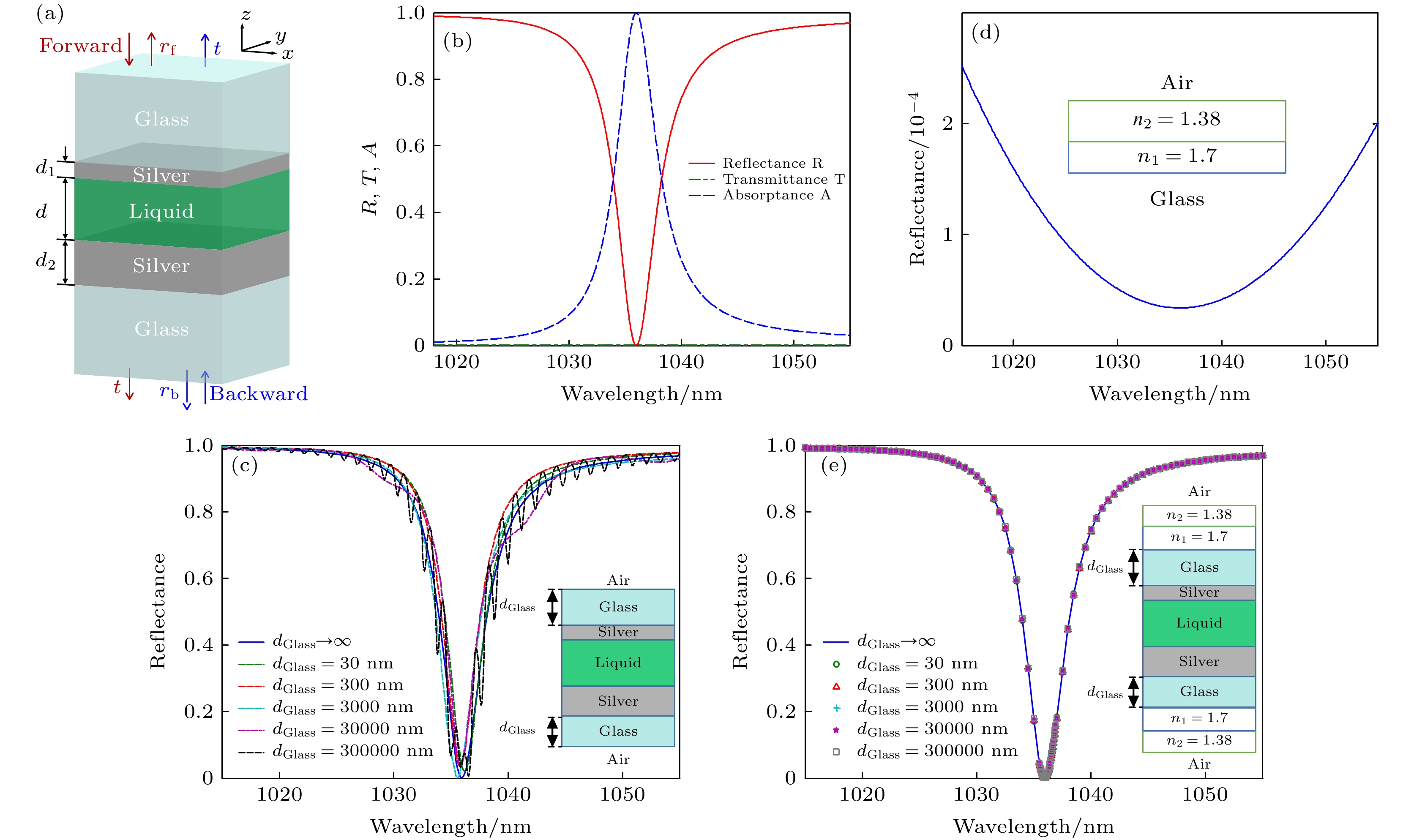
 下载:
下载:

